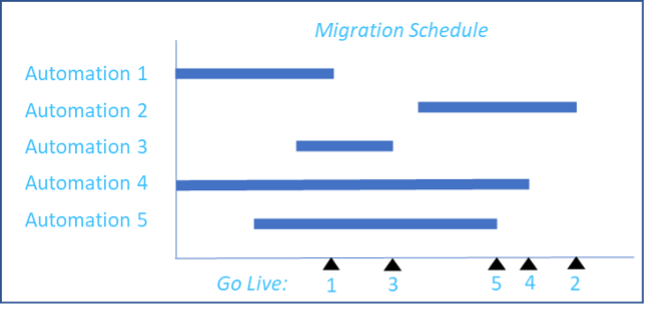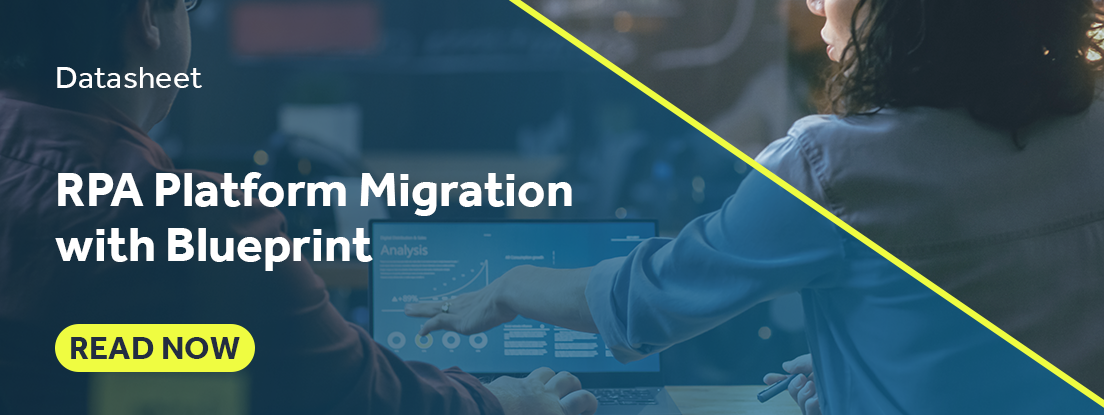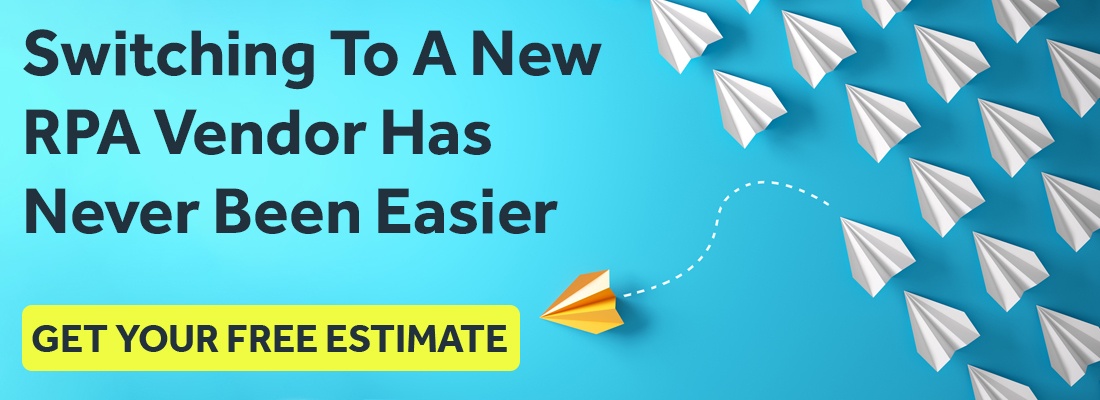How to Plan for an RPA Migration
There is a lot of interest in migrating RPA estates from expensive and complex legacy RPA tools onto next-generation, intelligent automation platforms like Microsoft Power Automate.
The first step of an RPA migration is building a business case in order to get funding and executive sponsorship.
Learn More: How to Build an RPA Migration Business Case
Once the business case has been built and approved, it’s time to plan your RPA migration. These are the 8 steps that make up a successful, cost-effective, and efficient RPA migration plan.
Step 1 – Assess your automation estate
Before thinking about how you’re going to migrate your RPA estate to another automation platform, it’s critical that you understand what you have in your estate first.
Because organizations started their automation journeys 5 or maybe even 10 years ago on legacy technologies that might have changed or had parallel automation programs in different business units that lacked centralization, companies don’t really know everything they have in their RPA estates.
Having access to the information and details on your current estate gives you the visibility you need to understand the automations you have in production right now. It’s also an opportunity for analysis to identify:
- where automated processes are unnecessarily complex
- where there are redundancies that can be removed
- and which processes can be retired to cut costs.
For example, on average, 30% of RPA estates are redundant. If your automation practice costs $1 million annually, that’s $300,000 you can wipe off your books. Assessing your automation estate before migrating with the right metrics, ensures you don’t port over waste and that you only move the automations that deliver value.
Step 2 - Define the scope of the automated processes you want to migrate
If you’ve assessed your automation estate before migration, this step is much easier and quicker to complete.
Analyzing which processes to optimize and which ones to retire after assessment essentially defines the scope of which automations you will be migrating to your new, destination RPA platform.
In some cases, organizations decide to simply create net-new automations in a new intelligent automation platform, however, this increases OPEX (operational expense) as you have to maintain two RPA platforms and all the licensing and utilization costs that come with it.
One element of this step that is recommended, is to categorize your automations to be migrated according to size and complexity. The t-shirt sizing method familiar to all developers (small, medium, large) is a good practice that will aid with the next step of your migration plan.
Step 3 - Define the phases of migration waves/sprints
The most successful RPA migrations are iterative. There should be no disruption in terms of operations. Parallel running of automations in your new RPA platform and your legacy tool is suggested.

An iterative approach minimizes the impact on business and ensures you can keep the lights on for your automation practice as you’re switching platforms. It also enables you to apply the learning you gather from migrating the low-hanging fruit at the start, so errors are mitigated and migrations pick up pace as you go.
Step 4 - Design development framework
RPA governance is something many automation practices are still trying to get right. Migrating your automation estate to a new platform provides an opportunity to improve governance and standardization across your entire practice.
This is also a particularly important step for the migration itself. RPA platforms define process automations differently, so it’s imperative you establish how you’re going to treat command mismatches, the different uses of connectors, etc. so there is consistency, quality, and standardization.
This is especially true for manual migrations, however, when you use a solution like Blueprint that automatically converts your automations according to our intensive library of commands and actions, standardization and consistency are a natural by-product, not to mention time and cost savings.
Step 5 - Set up the environment of your new intelligent automation platform
Before starting the actual migration of your RPA estate, it’s important to set up your environments in your new intelligent automation platform.
That means user management activities like defining the users on the new platform in addition to distributing credentials. Your development, testing, and production environments should also be configured in this step, as well as any corresponding security policies you need to apply.
Step 6 - User enablement and training
In this step, training doesn’t only mean enabling users that will be performing the migration; it also refers to empowering the business users, developers, and administrators that will be working in your new intelligent automation platform.
This is where a tool like Microsoft Power Automate really stands out. The familiarity of Microsoft’s UI accelerates the learning curve and really facilitates a citizen development approach if your plan is to enable business users to design and deliver automations for scale and real ROI.
Step 7 - Define individual roles and responsibilities for migration
You should define the stakeholders and roles for your RPA migration the same way you defined the roles and responsibilities of your RPA CoE (Center of Excellence).
A successful migration of your automation estate that stays within budget and defined timelines hinges on the premise that everyone who is part of the project understands their roles, including the business users and business units that are stakeholders in automation.
Step 8 - Licensing strategy
Your defined licensing strategy also borrows from the business case you built for RPA migration. Most automation migrations are driven by efforts to reduce costs from a licensing and OPEX perspective. It’s why Microsoft’s competitive pricing is making Power Automate such a popular destination for switches.
Learn More: 10 Reasons Microsoft Power Automate is the Right Move for You
Microsoft’s enterprise footprint also plays a role here as so many companies already use Microsoft products like Office or Azure, making licensing structures for Power Automate flexible to suit your specific needs.
Either way, how you’re going to manage licensing so it doesn’t inflate the total cost of RPA ownership over time is important to define here. It also plays a role in your migration planning. Most migrations are planned around the renewal dates for their legacy RPA platform. Therefore understanding the licensing end dates of your current tool and how they will overlap with parallel runs as you move onto your new automation solution is paramount.
To learn more about how Blueprint can automatically migrate your RPA estate to powerful intelligent automation platforms like Microsoft Power Automate, set up a free consultation with one of our solution architects who can also provide a free estimate on migration.
Share this
Recent Stories

Microsoft Power Automate Solutions for Automation Challenges

5 Tips on How to Assess your Automation Estate





